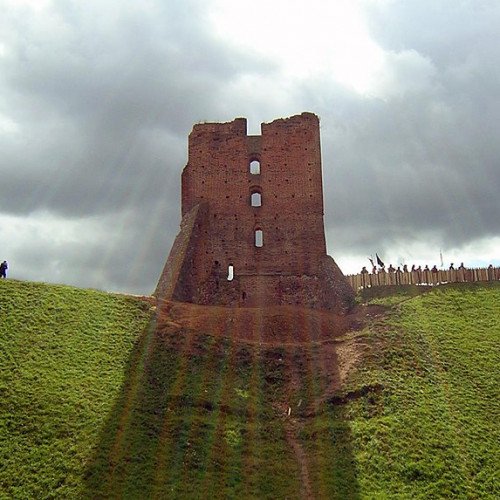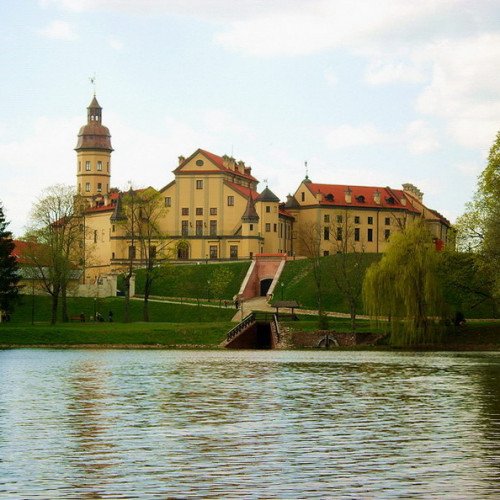Castles of "Belarus" NAVAHRUDAK CASTLE vs NESVIZH CASTLE

NAVAHRUDAK CASTLE
The former castle in Navahrudak, Belarus (Belarusian: Навагрудскі замак, Lithuanian: Naugarduko pilis, Polish: Zamek w Nowogródku) was one of the key strongholds of the Grand Duchy of Lithuania, cited by Maciej Stryjkowski as the location of Mindaugas's coronation as King of Lithuania as well as his likely burial place. Modern historians cannot make up their minds as to the true location of Mindaugas's coronation. As early as the 14th century, Navahrudak is known to have possessed a stone tower along the lines of Tower of Kamyanyets. Other fortifications were of timber. The castle was stormed by the Teutonic Knights under Heinrich von Plötzke in 1314. Although the attack was not successful, the tower sustained substantial damage. During the reign of Vytautas the Great four new stone towers were added to the system of Navahrudak fortifications. In the 17th century the main castle boasted 7 towers, apart from those of the Lesser Castle. Navahrudak was one of the northernmost forts besieged by the Crimean Tatars in the 16th century. Navahrudak was twice occupied by Russian forces during the Russo-Polish War (1654–67). Further destruction was inflicted by the Swedes who sacked Navahrudak as part of the Great Northern War in 1706. Attempts to preserve the ruins from further decay were undertaken in the 1920s. The castle grounds at present provide the setting for medieval reenactment and theatrical jousting.
Statistics for this Xoptio

NESVIZH CASTLE
Niasviž Castle or Nesvizh Castle (Belarusian: Нясьвіскі замак, Niasvižski zamak, Polish: zamek w Nieświeżu, Lithuanian: Nesvyžiaus pilis) is a residential castle of the Radziwiłł family in Niasviž, Belarus. It is 183 metres (600 ft) above sea level. Built in the 16th century and 17th centuries, and maintained by the Radziwiłł family until 1939, the castle and the nearby Corpus Christi Church were instrumental in the development of Central European and Russian architecture. In 2005, the castle, church, and surrounding environment were inscribed on the UNESCO World Heritage List. The estate was owned by the Radziwiłł magnate family from 1533, when it was awarded to Mikołaj Radziwiłł and his brother Jan Radziwiłł after the extinction of the Kiszka family. Since the Radziwiłłs were one of the most important and wealthy clans of the Grand Duchy of Lithuania and the Crown of the Kingdom of Poland, it was there that the Lithuanian Archive was moved in 1551. In 1586 the estate was turned into an ordynacja. After the Union of Lublin the castle became one of the most important residences in the central part of the Polish–Lithuanian Commonwealth. In 1582 Mikołaj Krzysztof "Sierotka" Radziwiłł, the Marshal of Lithuania, Voivode of Trakai–Vilnius and castellan of Šiauliai, started the construction of an imposing square three-storey "château". Although the works were based on a pre-existing structure of a medieval castle, the former fortifications were entirely turned into a renaissance-baroque house. Construction was completed by 1604, and they added several galleries half a century later. The château's corners were fortified with four octagonal towers. In 1706, during the Great Northern War, Charles XII's army sacked the castle and destroyed its fortifications. Several decades later, the Radziwiłłs invited some German and Italian architects to substantially renovate and enlarge the castle. Antoni Zaleski decorated its yellow facades with baroque stucco work. The 16th-century castle gates were also reconstructed, and the two-storey gatehouse tower was crowned with a helm. It was at this time that the three separate buildings surrounding the central courtyard were joined into a single structure.